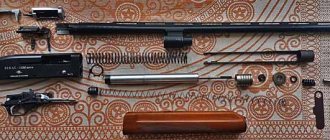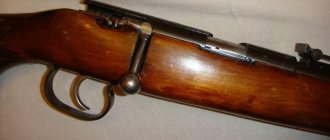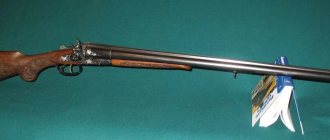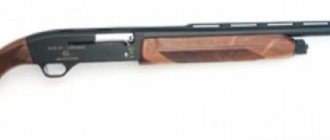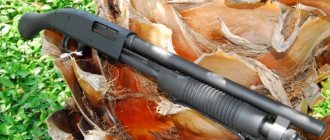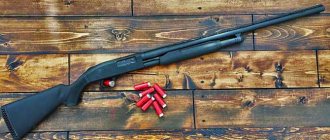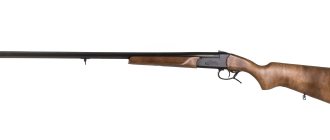Description of the gun Bekas 12M
Domestic smoothbore pump-action shotgun snipe 12m
12-gauge smoothbore shotgun with pump-action reloading method. The movable forend slides along the under-barrel tubular magazine. The barrel is cold forged, with a chrome-plated channel and an extension at the muzzle, where replaceable choke nozzles are installed.
Sights - ventilated rib and bronze front sight. Installation of optics is not provided. The stock is semi-pistol, made of solid walnut wood. The delivery set may include a plastic pistol grip.
A review of the Bekas 12-M shotgun is shown in this video:
Advantages and disadvantages
This is truly the Real McCoy of the gun world. The gun is extremely unpretentious in operation and does not require excessive maintenance efforts. Due to the pump-action type of reloading, failures to fire are simply impossible.
- The bore is chrome-plated, which makes the weapon easier to care for and improves its ballistics. It has space for interchangeable nozzles with choke constrictions of different gradations. Installing the nozzle inside the barrel guarantees perfect alignment.
- The long chamber allows you to vary the type of ammunition depending on the intended type of hunting. Firing cartridges with short cartridge cases (70 mm) somewhat degrades the accuracy and sharpness of the fire, but is not dangerous, neither for the shooter nor for the weapon.
- Excessively noisy for a hunting weapon, a particularly loud click occurs when the bolt cylinder wedge engages the cutout in the barrel shank.
- The forend is long, with a well-developed notch, it is convenient for reloading, regardless of the anatomical features of the shooter.
- Twelve-gauge cartridges are loaded with a large amount of shot, so the size of the scree makes shooting at a bird in flight very effective. However, for such a bonus you have to endure a brutal return. Not everyone can afford a gun. The instructions specifically state that shooting with a pistol grip and a long barrel is prohibited, as it can cause hand injuries.
- Reliable locking of the barrel bore by a swinging cylinder, the wedge of which engages with a cutout in the breech shank, ensures good ballistic qualities of the weapon. Shooting with bullets of any system is accurate; the MOA value at a distance of 70 meters does not exceed 2 units.
- There is a lever to stop the bolt frame halfway. This allows you to remove the cartridge from the chamber and not feed it from the magazine, which is convenient for transporting weapons - there is no need to empty the magazine, as well as for quickly replacing it with ammunition with a different type of equipment.
- The semi-pistol stock made from solid walnut wood complies with all the canons of shooting art and is quite convenient for shooting from all positions for a conventional shooter with average anatomical parameters. However, the inability to adjust the height of the buttplate has led to criticism that reaching the trigger may be difficult.
The gun is relatively light, with it you can walk through forest and swamp wilds all day without any problems.
Carbine Bekas 12 M (photo)
Purpose
The gun is produced only in 12 gauge and with a chamber length of 76 mm. Models with a long barrel are used for hunting small and medium-sized animals, upland birds and waterfowl. The short barrel is used for self-defense and shooting bullets at short distances.
Varieties
Until 2012, the Vyatsko-Polyansky Arms Plant produced 8 models of this gun with barrels of 535, 680, 720 and 780 mm in single or combined configurations. To date, only two are being produced.
- VPO-202-04 with a 535 mm long barrel and a semi-pistol walnut stock. The delivery set includes a pistol grip and two interchangeable choke tubes – a payload and a “Paradox” (the cylinder is pre-installed in the barrel) 150 mm long.
- VPO-202-07 Snipe RP with a set of barrels 535 and 750 mm. The set of interchangeable choke constrictions is the same.
Technical characteristics of Bekas auto 12 M are given below.
Design features
The Bekas 12M is a 12-gauge smoothbore pump-action shotgun. The barrel of the Bekas 12 shotgun is made by cold forging, blued, with a chrome-plated channel. The muzzle has an extension for installing replaceable nozzles - payload or paradox.
The under-barrel magazine is a tubular type, designed for six charges. The barrel box is made by casting, for which aluminum alloy was used. The store's bunker window is located on the bottom edge.
The Bekas 12 model is equipped with a trigger mechanism. It should be noted that the striker is not adjustable along the hook path or trigger force. The safety flag in Bekas 12 is located on the rear branch of the trigger guard and can be in one of two positions:
- shift to the left, at right angles to the barrel axis - off;
- when you shift to the right, you can fire.
When the safety is turned on, the bolt frame can only be opened half the length of the cartridge case; it is impossible to feed a cartridge and cock the firing pin.
On top of the trigger, on the right, there is a lever that cuts off the supply of cartridges. When pressed, the bolt frame can be retracted to the entire length of the cartridge to remove it from the barrel. In this case, the next ammunition is not supplied to the elevator, and the firing pin remains in the cocked position.
The stock of the Bekas 12 pump-action shotgun has a semi-pistol shape and is made from walnut wood. The Bekas 12 M stock is distinguished by a straight comb, strongly inclined downward in relation to the barrel. The shock-absorbing butt pad is not adjustable. The handle along its entire length is corrugated, improving the grip. Long walnut fore-end. If the barrel channel is locked, it reaches the front edge of the box.
The Bekas brand hunting rifle is equipped with external sighting devices in the form of a ventilated rib and a bronze front sight.
Assembly and disassembly
Snipe hunting rifle
Not everyone fully understands how the process of disassembling and assembling a pump-action shotgun occurs. So we decided to leave here a small instruction that will serve as an action algorithm for those who decide to disassemble the “Snipe” with a mechanical semi-automatic machine:
Self-loading shotgun Bekas disassembled
- We unload the gun. To do this, you must first press a special button, which is located under the trigger, and then pull the forend towards you - all the cartridges will jump out of the magazine (including the one that was already in the chamber). After releasing the ammunition, you should move the elevator back forward and perform a control descent of the trigger so that further disassembly does not cause difficulties.
- Removing the barrel coupling. To do this, you will need to use the key that comes with the Bekas. Simply use it to unscrew the shaped nut, then remove the coupling and put it aside.
- Removing the bolt frame and barrel. First you need to move the forend back, and then separate the cylinder and the breech. After this, you can release the bolt carrier and also remove the barrel (just unscrew it counterclockwise).
- Removing the trigger. The trigger mechanism is attached to the receiver using several bolts that can be unscrewed with a special key. Once the bolt carrier rod clamp is removed, separating the trigger from the rest of the part is not difficult.
- We remove the forend. The last stage of disassembly, which will not cause any particular difficulty, because the pump-action mechanism will no longer be held by the bolt rod lock. Simply pull the forend towards you and carefully separate it from the body of the weapon.
Assembling a pump-action shotgun must be carried out strictly in the reverse order. If you violate the algorithm of actions, then difficulties will probably arise in the process or some system will be completely damaged.
Disassembly
- Unload the weapon by pressing the lever above the trigger, pull the forend back and remove the cartridge from the chamber. After this, move the elevator inside the receiver, and move the forend even further back and empty the magazine. Perform a control descent of the trigger.
- Unscrew the shaped nut on the barrel coupling and remove it from the magazine.
- Pull the forend back so that the cylinder comes out of sync with the breech. Remove the barrel.
- Squeeze out the hammer mechanism mounting pin and remove it from the receiver.
- Using the same pin, remove the forend rod lock from the bolt frame.
- Remove the bolt carrier from the receiver.
- Remove the forend (along with the rods) from the magazine.
- Remove the bolt through the barrel hole, push out the pin, remove the firing pin, spring and separate the bolt cylinder.
Specifications
Considering that the Bekas 12M shotgun is the most popular model of the entire line, it would be unfair not to get acquainted with its technical characteristics in more detail. The performance characteristics of the Bekas 12M shotgun are given in the table.
| Characteristic: | Parameter: |
| Weapon type | smoothbore shotgun with movable forearm |
| Barrel caliber | 12 (18.6 mm) |
| Chuck used | 12/70 mm |
| Barrel type | smooth, chromed |
| Barrel length | 750 mm |
| total length | 1150 mm |
| Magazine capacity | 6+1 rounds |
| Weapon weight | 3600 kg |
The accuracy of the Bekas-12M is 55% when firing from a distance of 50 meters with cartridges with a standard load of gunpowder and shot (almost 10% more than the progenitor Bekas-12). This is due to the longer barrel, as well as the additional choke in the kit. We also present the characteristics of VPO-202-04, one of the Bekas modifications.
| VPO-202-04 | VPO-202-04 | |
| Type | Smoothbore shotgun with movable fore-end | |
| Caliber | 12, chamber 76 mm | |
| Trunk | Chromium-plated | |
| Barrel length (mm) | 535 | Set 535 and 750 |
| Replaceable choke tubes | Paradox and payday 150 mm. Cylinder pre-installed | |
| Magazine capacity | 6 | |
| Overall length (mm) | 844 | 1301 |
| Weight, kg) | 3,3 | 3,6 |
Price and reviews
- On the website of the Vyatsko-Polyansky Machine-Building Plant, the VPO-202-04 model costs 19,500 rubles (about the same as, for example, Saiga 20K), and the VPO-202-07 model costs 24,100 rubles (like the Saiga-MK isp.03, VEPR-223 PIONEER and etc.).
What are the reviews from the owners of the Bekas auto 12 M pump gun?
- The gun is trouble-free in operation, it is indifferent to the type and quality of ammunition.
- The combat is tight and sharp.
- The recoil is strong.
Advantages and disadvantages of Bekas series shotguns
The main advantages of Bekas pump-action shotguns are as follows:
- Pump-action shotguns around the world are famous as trouble-free and very reliable. According to these factors, they are slightly inferior to double-barreled shotguns, but they are superior in rate of fire. Since after a misfire, a gun of this type can be quickly reloaded, this has made it very popular among the police and intelligence services of various countries;
- The bore is chrome plated. This makes cleaning the gun much easier. The barrel provides space for installing nozzles with various choke constrictions;
- Shotguns of 12x76 caliber make it possible to shoot cartridges with a case length of 76 mm. The use of shorter cartridges slightly worsens the accuracy and range of the weapon, but you can be sure that it will not fall apart in the hands of a hunter;
- The long handguard with a notch makes the reloading process very convenient. Judging by the reviews of hunters, they do not experience any discomfort when reloading, despite different anatomical features;
- The gun has excellent ballistic characteristics. This affects both shot and bullet shooting;
- Thanks to the presence of a special lever, you can stop the movement of the shotgun bolt frame halfway. This can help remove a round from the chamber without feeding other rounds from the magazine. Thanks to this feature, it is possible to urgently load a weapon with one cartridge of a different caliber;
- The half-pistol stock is made very comfortable, so it does not cause any complaints from hunters;
- The gun is quite light, so it can be used for long walking hunts.
Snipe shotguns also have their disadvantages:
- For hunting, the sound of the reloading mechanism is too loud; in the forest it can be clearly heard at a considerable distance. The loudest sound is heard when the bolt cylinder wedge engages a special cutout, which is located in the barrel shank;
- When fired with shot, 12-gauge cartridges, although they increase the radius of destruction, at the same time create a very powerful recoil. This feature makes a 12-gauge shotgun not suitable for all hunters. In addition, when shooting without a stock, the possibility of injury increases many times over, since strong recoil can simply fly the gun into the hunter’s forehead;
- The butt plate is non-adjustable, which is very criticized by experienced hunters.
Design
- A smoothbore shotgun with a movable fore-end is a pump-action type of reloading.
- The barrel is cold forged, blued, the bore is chrome plated. On the muzzle there is an extension for installing replaceable nozzles - “Paradox”, pay (the cylinder is pre-installed).
- The magazine is tubular, under-barrel, with a capacity of six rounds.
- Receiver made of aluminum alloy, cast. The store bunker window is located on the bottom edge.
- The shutter cylinder is swinging. It locks the bore by engaging with a cutout in the breech shank. The firing pin is spring-loaded, its tip does not extend beyond the shutter mirror.
- Trigger mechanism of hammer type. It is not regulated. Neither in the direction of the hook, nor in the release force. The safety box is located on the rear branch of the trigger guard and has two positions: shift to the left, perpendicular to the axis of the barrel, - off; shift to the right - fire. When the safety is on, the bolt frame opens only half the length of the cartridge case, feeding the cartridge and cocking the firing pin is impossible.
- Above the trigger, on the right, there is a cartridge feed cut-off lever. If you press it, the bolt carrier can be retracted to the full length of the cartridge case, and the cartridge can be removed from the barrel. But there will be no supply of ammunition to the elevator. The drummer cocks.
- Semi-pistol stock made of solid walnut wood. Buttstock for Snipe 12 M with a straight comb, which has a strong downward slope relative to the axis of the barrel. The butt plate is shock-absorbing, non-adjustable. The entire length of the handle is grooved for a comfortable and secure grip. The forend is made of the same material, long, and when the barrel is locked, it reaches the front edge of the receiver.
- External sights – high ventilated rib and bronze front sight.
Snipe RP-12M-05 (photo)
Operating principle
- The gun is loaded through the hopper window at the bottom of the receiver. Before you start loading the magazine, you must put the safety on. The feed elevator is retracted inside the receiver. The cartridges are placed one after the other with the cartridge case facing forward and secured in the magazine.
- It is possible to charge an additional or single cartridge, but in this case the safety must be turned off. If there are cartridges in the magazine, you need to press the catcher lever above the trigger and move the forend back so that the cartridge ejector window is completely open. In this case, the feed elevator is lowered, so when using cartridges with a short case, you need to turn the gun on its side, then the ammunition will not fall down into the hopper. A magnum cartridge can simply be pushed into the chamber with your finger.
- As the forend moves backward, its rods push the bolt frame, the cylinder lowers and disengages from the shank of the barrel breech. The spent cartridge case is removed and the firing pin is cocked. When the bolt frame reaches the butt plate of the receiver, the cartridge case is ejected by the reflector lever, and the tooth of the left handguard rod opens the magazine and feeds the cartridge into the tray. During the reverse movement, the elevator rises and supplies the cartridge to the loading line. The bolt cylinder picks it up and sends it into the chamber. At the same time, its wedge tooth engages with the hole in the breech of the barrel.
- To empty the magazine, move the elevator inside the receiver and pull the forend back.
Disassembly of the Snipe auto 12 M is shown below.
Shooting for accuracy of the Bekas 12-M shotgun is shown in this video:
Ammunition
A pump-action shotgun can fire both shotshells and slugs. The most common is 12 gauge, much less 10, 16, 20 and 36 (.410) gauges. Our arms industry has so far mastered the 12th (IZH-81, TOZ-94, TOZ-194) and 16th (Bekas) calibers. 12 gauge is available in three sizes on the international market: 12x70 (2 3/4 inches), 12x76 (3 inches) Magnum and 12x89 (3 1/2 inches) Super Magnum. The overall effectiveness of the shot, as well as the recoil perceived by the shooter, increases with increasing these parameters. Each barrel is marked with a stamp containing information about what cartridges are allowed to be used in it. In a barrel with a chamber length of 70 mm, it is impossible to use cartridges with a 76 or 89 mm sleeve. A barrel marked 12×70 and 12×76 allows the use of both types of cartridges, etc.
Problems of choice
There are many factors to consider before purchasing a specific model. So, each type has its own characteristics.
- Shooting from a traditional bow will have to be done intuitively, since this weapon does not have any additional devices.
- A traditional recurve bow has a special bend that adds power to the weapon. That is why it is recommended to purchase the recursive option.
- Classic is more accurate than traditional. It can also be equipped with a sight and stabilizer.
- Any classic bow is recurve. Weight does not exceed 1.5 kg, if we talk about modern models.
The most accurate and effective is the compound bow. However, it has the most complex design.
- The main elements are two wheels located at the ends of the arms, as well as crossed cables. Thanks to the wheels, the effort required to maintain maximum stretch is significantly reduced.
- It's comfortable to use, but very difficult to set up.
- Often, block ones are chosen for hunting. Some hunters stop using firearms completely.
- For fun, you can choose a simpler bow.
An important point when purchasing is the purchase of additional accessories, if any are missing.
To ensure finger protection, you must purchase a finger guard. In addition, your hand should have a gaiter that can protect you from the blow of a bowstring. You can also buy a target and, of course, you need to buy several arrows
As a rule, arrows are consumable and can easily break or get lost somewhere. It is important to consider that if the tension force is more than 27 kg, then it will have to be registered. In other cases, this will not be necessary.
Combat effectiveness
During the period from the 11th to the 13th centuries, the main weapon of warriors was spears. However, after some time, spears were replaced by bows. They began to be used all over the world. In particular, in England, Rus' and Asia, the appearance of the bow upended all military standards and ideas about weapons.
Sport bow.
As it turns out, bows are quite effective weapons. With their help it was possible to wound a horse at a distance of up to 150 meters. At a distance of up to 50 meters, it was possible to pierce the enemy’s armor, after which the arrow calmly pierced the body. Moreover, the arrow could pierce through all armor, the human body, and even mortally wound a horse.
Thus, a classic bow releases energy when the bowstring is released. The arrow's flight speed is up to 50 m/s. At the same time, such an arrow does not have much penetrating power. Its advantage is its rate of fire. However, to ensure this effect, you should not fully pull the bowstring.
The arrow of a compound bow accelerates slowly, but the flight speed is higher than that of the classic model and is 90 m/s. It is also possible to use heavy arrows with greater penetrating power
The important thing is that you cannot apply incomplete tension to the bowstring. The advantage is precision
Block type bow.
Ease of ownership
In fact, the bow is quite comfortable to wield, as it can be adjusted to suit the height of any shooter. Thus, classic models are made collapsible to create the possibility of replacing the shoulders with short or long ones. Also, the shoulders can be hard or elastic. To adjust the block type, you need to change the position of the blocks on the eccentrics.
The bow can be adjusted to suit any height.
Price
The question of the price of a specific weapon model has always been relevant and interesting. To date, nothing has changed.
For example, if we take into account efficiency and equipment, then the classic models will be the cheapest.
In principle, for 15 thousand rubles it will be more profitable to buy a compound bow. Its tension force will reach 21 kg, and there will be no need to spend money to provide additional adjustment. The set will also include several arrows, a sight, a shelf and a shako.
Ancient bow.
Goals and objectives
For many people, archery is just entertainment. However, it is actually a fairly versatile weapon that can perform many tasks. The bow is an excellent weapon for hunting any animal. In addition, many centuries ago, the bow was the main weapon of any warrior.
Today, in addition to hunting, they are used in sports competitions. Also, shooting can improve the health of the shooter, since during training the muscles of the arms, body, chest and shoulders develop.
Bows are used for sport and hunting.
Equipment used
Soviet medium tanks T-34 (about 70%), heavy - KV-1S, KV-1, light - T-70, self-propelled artillery units, nicknamed "St. John's wort" by soldiers - SU-152, as well as SU-76 and SU-122 met in confrontation with German tanks Panther, Tiger, Pz.I, Pz.II, Pz.III, Pz.IV, which were supported by self-propelled guns "Elephant" (we have "Ferdinand").
Soviet guns were practically unable to penetrate the 200 mm frontal armor of the Ferdinands; they were destroyed with the help of mines and aircraft.
Also the Germans' assault guns were the StuG III and JagdPz IV tank destroyers. Hitler relied heavily on new equipment in the battle, so the Germans postponed the offensive for 2 months in order to release 240 Panthers to the Citadel.
During the battle, Soviet troops received captured German Panthers and Tigers, abandoned by the crew or broken. After the breakdowns were repaired, the tanks fought on the side of the Soviet army.
List of forces of the USSR Army (according to the Ministry of Defense of the Russian Federation):
- 3444 tanks;
- 2172 aircraft;
- 1.3 million people;
- 19,100 mortars and guns.
As a reserve force there was the Steppe Front, numbering: 1.5 thousand tanks, 580 thousand people, 700 aircraft, 7.4 thousand mortars and guns.
List of enemy forces:
- 2733 tanks;
- 2500 aircraft;
- 900 thousand people;
- 10,000 mortars and guns.
The Red Army had numerical superiority at the beginning of the Battle of Kursk. However, the military potential was on the side of the Nazis, not in quantity, but in the technical level of military equipment.
The lineup
VPO-201-05
Semi-automatic shotgun with a gas engine chambered for 12x76 cartridges. Magazine for 3 matrons without the possibility of extension. The set includes two 535 mm barrels with a front sight and rear sight for bullet shooting and a 750 mm shot barrel with a ventilated rib.
VPO-201M
A self-loading hunting rifle, it has a 12×76 chamber, which allows the use of both conventional ammunition and magnum cartridges. VPO 201M is made with a new and simplified gas unit. To reload the weapon, use a piston without adjustments, which ensures stable operation of the gun in various conditions and facilitates cleaning of the gas unit.
The new Bekas 201m is created in a classic style, the forend and butt are made of walnut, the butt has a comfortable anatomical shape. The receiver has a weaver rail for installing collimator, optical and night sights.
The gun is equipped with two 535mm long barrels for bullet shooting with a forged paradox, rear sight and front sight, and a 750mm barrel for shotgun shooting with a ventilated rib. Also, due to the new gas unit, the gun allows the use of various extensions for the cartridge magazine and 2 extensions for 3 and 6 rounds are supplied with the gun.
Pros:
- Soft descent.
- High quality trunks.
- Having two barrels.
- The bullet barrel has a built-in paradox.
- Weaver rail for easy placement of various sights.
- New stock and forend design.
- Rich equipment.
- Simplified gas unit, simplified cleaning.
- Possibility to install extension cords on the magazine.
Minuses:
- A short barrel with a paradox, which makes it impossible to use shotgun cartridges.
- Forend play.
- Some of the guns have a play in the barrel and a poorly welded front sight on the short barrel.
Care and disassembly
Shotguns of the Bekas series are distinguished by their fairly high unpretentiousness, provided, of course, that the basic rules and measures for caring for the weapon are followed. Of course, like any weapon, they need regular lubrication, careful storage and handling, and compliance with transportation rules.
Disassembling weapons of this family is quite simple, thanks to the same modular design principle. For partial disassembly and cleaning, which is recommended after each use, the special key and drift included in the kit is sufficient. For complete disassembly you will also need a slotted screwdriver.
Disassembly and cleaning is carried out with the weapon unloaded, strictly following the instructions supplied with the gun. Since the trigger mechanism is a rather complex and responsible device, it is not recommended to disassemble the trigger unless absolutely necessary. The remaining parts should be thoroughly cleaned of powder deposits and carefully lubricated. Complete disassembly of the weapon is carried out once a year - at the end of the hunting season.
Despite the insane competition that exists today in the market for smooth-bore hunting weapons, the Bekas series shotguns have gained quite a high popularity and have quite successfully occupied their niche. This is evidenced by the number of collected copies of various modifications, which exceeded 50,000!
General description of the FGM-148 Javelin
“Javelin” is a new generation ATGM operating on the “fire and forget” principle. Designed to destroy tanks, vehicles and even helicopters.
The device includes two modules:
Transport and launch container (TPC) and command and launch device (KPU).
The TPK is a disposable launch pad in the form of a tube with the rocket itself in it, while the KPU is a module containing controls, optical instruments, power supply, and can be used repeatedly with other TPKs.
Command-Launch Device (in English CLU)
The KPU includes:
- Night sight based on a thermal imager.
- Optical sight.
- Handles with control elements.
- Stirling's engine.
- Visir.
- Battery BA-5590/U for powering systems.
The main working element of the ATGM is a thermal imaging camera that forms an image regardless of weather conditions. The sensor has a resolution of 240 x 480 pixels.
To register weak thermal radiation from a target, it is necessary that the camera lenses and matrix are sufficiently cold, otherwise the useful signal will dissolve in its own thermal noise. To solve this problem, the sight is equipped with a cooling unit powered by a miniature Stirling engine. The required time for complete cooling is 2 minutes 35 seconds.
The matrix is located in a Dewar flask with a vacuum, which may leak over time and therefore the developer reports a limited storage time of 10 years. The CPU sensor can operate without cooling if the target has sufficient thermal contrast.
Two data connectors are located on the right side: the first for connecting to a simulator or updating software and the second for transmitting data to the rocket. At the bottom there are two pistol-type handles, on which the shutter button, sharpness controls, changes in the sensitivity limit and other display parameters are located.
The image from the camera is displayed in the center of the viewfinder, and various indicators are located around the perimeter:
- Day – Day sight;
- WFOV – night sight with 4x magnification;
- NFOV – night sight with 12x magnification;
- SEEK – view from the camera of the rocket itself (viewfinder). The viewfinder turns on after placing the marker;
- TOP – attack from above is selected;
- Dir (Direct) – direct attack is selected;
- FLTR – reflection filter enabled;
- NIGHT – The thermal imager is not cooled;
Red indicators indicate insufficient cooling temperature, battery voltage, or autodiagnostic errors.
Pressing the FLTR button brings up a special filter. The Javelin's large lenses, like any other optical sight, reflect the laser beam well. This reflection is recorded by special devices such as “Anti-sniper”, which are used by reconnaissance officers. This could pose a threat to the life of the operator even before the shot is fired, which is why the optics were equipped with a similar filter.
The filter should be used only when necessary - its main disadvantage is the deterioration of the sensitivity of the thermal imager.
All of the above devices require power, for which the BA-5590/U battery is provided. If there is no power supply, you can only use an optical sight for observation.
Transport and Launch Container
The launch tube is made of graphite fibers to reduce weight. Ammunition is mounted in the TPK at the assembly stage, where it is connected to cooling tubes and covered with lids. The rocket is equipped with its own cooling from compressed gas cylinders, and does not depend on the general cooling system.
The time required to cool the IR seeker is 10 seconds.
Assembly and disassembly of Bekas 12
Not everyone fully understands how the process of disassembling and assembling a pump-action shotgun occurs. So we decided to leave here a small instruction that will serve as an action algorithm for those who decide to disassemble Bekas with a mechanical semi-automatic machine:
- We unload the gun. To do this, you must first press a special button, which is located under the trigger, and then pull the forend towards you - all the cartridges will jump out of the magazine (including the one that was already in the chamber). After releasing the ammunition, you should move the elevator back forward and perform a control descent of the trigger so that further disassembly does not cause difficulties.
- Removing the barrel coupling. To do this, you will need to use the key that comes with the Snipe. Simply use it to unscrew the shaped nut, then remove the coupling and put it aside.
- Removing the bolt frame and barrel. First you need to move the forend back, and then separate the cylinder and the breech. After this, you can release the bolt carrier and also remove the barrel (just unscrew it counterclockwise).
- Removing the trigger. The trigger mechanism is attached to the receiver using several bolts that can be unscrewed with a special key. Once the bolt carrier rod clamp is removed, separating the trigger from the rest of the part is not difficult.
- We remove the forend. The last stage of disassembly, which will not cause any particular difficulty, because the pump-action mechanism will no longer be held by the bolt rod lock. Simply pull the forend towards you and carefully separate it from the body of the weapon.
Assembling a pump-action shotgun must be carried out strictly in the reverse order. If you violate the algorithm of actions, then difficulties will probably arise in the process or some system will be completely damaged.
Snipe-12 VPO-202-07
(2 barrels 750 mm and 535 mm, butt + pistol grip) The Bekas-12 multi-shot hunting shotgun of 12/76 caliber is intended for amateur and commercial hunting in conditions from minus 30 to plus 50 ° C in macroclimatic conditions with a temperate climate.
| Specifications | |
| Caliber | 12 |
| Barrel length, mm | 535, 750 |
| Barrel bore diameter, nominal value, mm | 18,5 |
| Chamber length, mm | 76 |
| Magazine capacity, cartridges (rolling type of injection) 12/70 (12/76) | 7 (6) |
| Weight of the gun (without accessories, case with belt), kg, no more | |
| with barrel length 535 mm and handle | 3,4 |
| with barrel length 535 mm and butt | 3,5 |
| with barrel length 750 mm | 3,7 |
| Overall dimensions, mm, no more | |
| with barrel length 535 mm and handle | 844x50x140 |
| with barrel length 535 mm and butt | 1067x50x140 |
| with barrel length 750 mm | 1301x50x198 |
Peculiarities:
- The barrel is removable and connected to the box by means of a locking block and a magazine nut.
- To increase the durability of the gun and its corrosion resistance, the barrel bore and chamber are chrome-plated.
- The barrel bore is locked by turning the locking wedge and inserting it into the barrel shank window.
- The trigger mechanism is mounted on a separate base.
- Tubular under-barrel magazine.
- The forend is movable, placed on the magazine body, connected to the bolt frame by means of two rods with protrusions.
- The gun has a locking lever that prevents the fore-end from moving backward in emergency situations when the hammer is cocked (with a cartridge in the chamber).
- The included push-button safety prevents a shot from being fired if the trigger is accidentally pulled.
Principle of operation:
- The principle of operation of the gun is as follows: when the forend is vigorously pulled back (towards the butt), the bolt frame with the bolt is driven by means of rods, while: the mainspring is compressed and the hammer is cocked;
- removing the cartridge case with an ejector and removing it outside the weapon with a reflector.
The offer on the site is for informational purposes only and is not a public offer. You can find out more detailed information about the availability, price, characteristics and configuration of the product from the managers by phone, or by writing to us at [email protected]
Winchester 1300 modifications
Options and modifications of the Winchester 1300 shotgun are as follows:
- Winchester 1300 - with a wooden stock and fore-end, 4-round magazine.
- Winchester 1300 Ranger - with a wooden stock and fore-end, a ventilated rib above the barrel, a 4-round magazine.
- Winchester 1300 Black Shadow - with a matte dark coating of metal parts, butt and forearm made of black plastic.
- Winchester 1300 Defender - with a 7-round magazine. The Winchester 1300 Defender series shotguns were conceived as weapons specifically for self-defense and security activities.
- Winchester 1300 Marine - with nickel-plated surfaces of metal parts to protect against corrosion when exposed to sea water.
- Winchester 1300 Coastal Marine is a modification of the Marine model with an aluminum alloy receiver and an 8-round magazine.
- Winchester 1300 Stainless Marine - modification using stainless steel. The Winchester 1300 Stainless Marine series shotguns are designed for use on a ship or near the sea and are made of special synthetic materials and alloys that are resistant to splashes, salt and temperature changes typical of the marine climate. The replacement of heat with cold in humid sea air causes the constant appearance of condensation on all surfaces, including hard-to-reach internal ones, and destruction invisible to the eye.
- Winchester 1300 Stainless Police - version for law enforcement agencies.
- FN Police Shotgun is a police modification of the Winchester 1300 Defender with modified sight settings for firing bullet cartridges, phosphating of metal surfaces, a 7-round magazine, butt and fore-end made of black plastic.
general description
12-gauge smoothbore shotgun with pump-action reloading Bekas. The movable forend slides along the under-barrel tubular magazine. The barrel is cold forged, with a chrome-plated channel and an extension at the muzzle, where replaceable choke nozzles are installed.
Sights - ventilated rib and bronze front sight. Installation of optics is not provided. The stock is semi-pistol, made of solid walnut wood. The delivery set may include a plastic pistol grip.
The development of the first Bekas began in 1997 at the Vyatsko-Polyansky machine-building plant Molot. The first sample used 16-caliber cartridges for firing, as well as a pump-action reloading system. Like most Russian shotguns, the new model was rather coldly received by hunting enthusiasts. Although it could not have been otherwise, since Russian arms factories extremely rarely took on the creation of pump-action shotguns, and even more rarely produced a high-quality semi-automatic model. However, the Hammer company did not give up.
At the turn of the century, the Bekas-16 gun received its first modification called Bekas-12M. In the new model, not only the concept of the barrel has changed, but also serious design changes have been made. For example, the pump has undergone a noticeable modernization, which in the new version began to work much easier and more confidently. Another year and a half later, a gun was released, called Bekas-12M-auto - in it the semi-automatic reloading mechanism was replaced with an automatic one (reloading was carried out using a gas engine).
Today, the Molot company has developed about 10 different modifications for the Bekas gun, each of which has several design options. However, all guns also have a huge number of similarities with the original, so lovers of the classics can choose any gun and will definitely not go wrong. The most recent development at the moment is considered to be the VPO-202 model, developed on the basis of the modernized Bekas-12-Auto. More details about this and other modifications in the next section.
History of creation
Initially, the Bekas gun was developed at the Vyatko-Polyansky Machine-Building Plant chambered for a 16-gauge cartridge. The first pump-action model, which went on sale in 1997, was called “Bekas-16”. Like any pump-action shotgun, the new model was received, if not with hostility, then rather coolly by domestic hunting enthusiasts.
At the turn of the century, some changes were made to the design of the product. The concept of the model range itself has also undergone modification. In 2001, the Bekas 12 M multi-shot shotgun (for 12 gauge) appeared. In addition, one of the latest modifications of this family of hunting weapons was the Bekas-M auto version, in which automatic reloading replaced manual pump-action reloading. Almost the same samples, without any fundamental changes, are presented today. The main modifications of the Bekas, which will be discussed below, are presented on the market today. At the moment, the latest development of the Molot-Weapon LLC company is the VPO-201M modernized Bekas 12 Auto.
Difference in modifications
As mentioned above, the modular principle used in the design of the Bekas family of hunting weapons allows you to easily combine the main components, creating one or another configuration, as in a children's construction set, for example, the Bekas 12 RP 12 m model.
The main details of this “constructor” are the following:
- classic stock;
- replaceable pistol grip;
- barrels chambered for 16x70, 12x70, 12x76 cartridges with lengths of 535, 660, 680, 720 and 750 mm.
However, there are also so-called basic configurations, which will be discussed further.
"Bekas 16"
“Bekas 16” is a traditional classic pump-action shotgun, reloading of which is carried out by moving a movable forend sliding along the tube of an under-barrel magazine that holds 6 rounds of 16-gauge (+1 in the barrel).
The very first version of the hunting rifle of this family, produced in three modifications:
- “Bekas” with a rifle butt and a barrel 717 mm long;
- "Bekas-1" with a butt and a short barrel (572 mm);
- "Bekas-2" with a pistol grip and a barrel 572 mm long;
- “Bekas-3” is a set that includes a stock, a “pistol” and two interchangeable barrels, long and short.
"Bekas-M"
An improved version of the previous version, chambered for 16- and 12-gauge cartridges. The principle of operation remained the same, although certain changes were made to the design aimed at increasing the accuracy of fire and the combat range. The gun can also be equipped with either a pistol grip or a classic butt. The under-barrel magazine holds 4 cartridges of 12x70 or 16x70 mm and another cartridge is carried in the barrel. The spring-loaded firing pin and push-button safety eliminate the possibility of an accidental discharge.
List of models on sale:
VPO-202
"Bekas-M auto"
A self-loading shotgun chambered for 12x70 or 16x70 mm, equipped with a system for smart cutting and discharge of powder gases. The weapon is reloaded using the energy of powder gases and the action of a return spring. Later modifications of the Bekas Auto 12x76, developed for the appropriate cartridge, are also equipped with a gas engine with automatic adjustment. In all other respects, this version of the gun is structurally similar to its older pump-action “brothers”. There is also the possibility of replacing the stock or barrel.
List of models on sale:
- VPO-201-05
- VPO-201M
Hunting with “Snipe”
Since our article does not promote any particular brand, we are based on reviews from real hunters. In this section, we are interested in how you can use a Bekas auto gun, or a modified armor of the same series, on regular hunting.
As research and experiments have shown, the Bekas family of shotguns has proven itself quite worthy in almost any type of hunting. Duck, goose, hare and even wild boar - all you have to do is choose the cartridge!
Thanks to the modular design discussed above, any weapon model can quickly transform into a hunting weapon, a weapon for self-defense, or even a “sniper” weapon! What is the reason for this diversity?
Firstly, versatility. Depending on the configuration and ammunition, even a relatively weak version of a 16-gauge shotgun cartridge with a “Snipe” shot will allow an experienced hunter to achieve his goal!
Secondly, the rate of fire. Obviously, 3 or even 6 rounds of ammunition in the “under-barrel magazine” provide a much higher rate of fire. However, this is where you need to understand the modifications!
